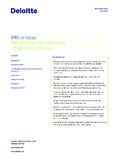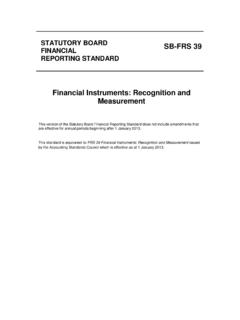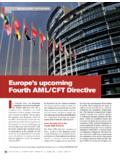Transcription of Financial Instruments - EY
1 Financial InstrumentsA summary of IFRS 9 and its effectsMarch 2017 IFRS 9 Financial Instruments RoadmapFVOCI(no rec ycling)Debt (including hybrid contr acts)DerivativesEquity(at instrument level)Conditional fair value option (FVO) elected? B usiness model test (at an aggregate level)Hold-to-collect contr actual cash Neither (1) nor (2)Amortised costFVOCI option elected ?BM with objective that results in Pas sYesYesNoNoFVOCI(with rec yclingFVTPLHeld for trading?FailNoNoFailFailBusiness model testChange in circumstancesRelevant information Performance evaluation & reporting Risks & risk management Remuneration It ems managed together Por tfolio segmentationUnit of accountResidual cat egory ver sus positive Collection of cash Relevance of salesType of objectiveBusiness model assessmentChanges in cr edit riskImpairment modelChange in credit risk since initial rec ognitionStage 1 Stage 2 Stage 3 Loss allowance updated at each reporting dateLifetime ECL criterionIn ter est revenue rec ognised (cr edit losses that result from default events that are possible within the next 12-months)(whether on an individual or collective basis)initial rec ognitionEffective Inter est Rat e (EIR))
2 On gross carrying amountEIR on gross carrying amountEIR on amortised cost(gr oss carrying amount le ss loss allowance)Cr edit-impairedDeteriorationImprovement L ow credit risk equivalent to investment gr ade Use change in 12-month risk as approximation for change in lif etime risk30 days pas t due b ackstop Assessment on a collective basis or at counterpar ty le velAssessing increas es in credit riskSet tr ansfer threshold by determining maximum initial cr edit risk(solely payments of principal and inter est)Compar eDisregard FailYesYesYesYesYesNoNoNoNoNoYesPas sde minimis or non-genuine?Is the time value element of the inter est rat e Other components of inter est consistent with basic lending-type return?Is there a prepayment f eat ur e at par ?rec ognition?Time value component differ ent from benchmark?Is the inter est rat e regulated and exception can be applied?
3 Contr actual undiscounted Undiscounted the benchmarkfinancial assetsLifetime ECLSPPIO verview of IFRS 9 Financial Instruments Financial asset classification based on business model and contractual cash flows test Financial liability accounting largely unchanged Impairment model amended from incurred to expected credit losses Hedge accounting aligned to how the entity manages the risksFVOCI(no rec ycling)Debt (including hybrid contr acts)DerivativesEquity(at instrument level)Conditional fair value option (FVO) elected? B usiness model test (at an aggregate level)Hold-to-collect contr actual cash Neither (1) nor (2)Amortised costFVOCI option elected ?BM with objective that results in Pas sYesYesNoNoFVOCI(with rec yclingFVTPLHeld for trading?FailNoNoFailFailBusiness model testChange in circumstancesRelevant information Performance evaluation & reporting Risks & risk management Remuneration It ems managed together Por tfolio segmentationUnit of accountResidual cat egory ver sus positive Collection of cash Relevance of salesType of objectiveBusiness model assessmentChanges in cr edit riskImpairment modelChange in credit risk since initial rec ognitionStage 1 Stage 2 Stage 3 Loss allowance updated at each reporting dateLifetime ECL criterionIn ter est revenue rec ognised (cr edit losses that result from default events that are possible within the next 12-months)(whether on an individual or collective basis)initial rec ognitionEffective Inter est Rat e (EIR))
4 On gross carrying amountEIR on gross carrying amountEIR on amortised cost(gr oss carrying amount le ss loss allowance)Cr edit-impairedDeteriorationImprovement L ow credit risk equivalent to investment gr ade Use change in 12-month risk as approximation for change in lif etime risk30 days pas t due b ackstop Assessment on a collective basis or at counterpar ty le velAssessing increas es in credit riskSet tr ansfer threshold by determining maximum initial cr edit risk(solely payments of principal and inter est)Compar eDisregard FailYesYesYesYesYesNoNoNoNoNoYesPas sde minimis or non-genuine?Is the time value element of the inter est rat e Other components of inter est consistent with basic lending-type return?Is there a prepayment f eat ur e at par ?rec ognition?Time value component differ ent from benchmark?Is the inter est rat e regulated and exception can be applied?
5 Contr actual undiscounted Undiscounted the benchmarkfinancial assetsLifetime ECLSPPIFVOCI(no rec ycling)Debt (including hybrid contr acts)DerivativesEquity(at instrument level)Conditional fair value option (FVO) elected? B usiness model test (at an aggregate level)Hold-to-collect contr actual cash Neither (1) nor (2)Amortised costFVOCI option elected ?BM with objective that results in Pas sYesYesNoNoFVOCI(with rec yclingFVTPLHeld for trading?FailNoNoFailFailBusiness model testChange in circumstancesRelevant information Performance evaluation & reporting Risks & risk management Remuneration It ems managed together Por tfolio segmentationUnit of accountResidual cat egory ver sus positive Collection of cash Relevance of salesType of objectiveBusiness model assessmentChanges in cr edit riskImpairment modelChange in credit risk since initial rec ognitionStage 1 Stage 2 Stage 3 Loss allowance updated at each reporting dateLifetime ECL criterionIn ter est revenue rec ognised (cr edit losses that result from default events that are possible within the next 12-months)(whether on an individual or collective basis)initial rec ognitionEffective Inter est Rat e (EIR))
6 On gross carrying amountEIR on gross carrying amountEIR on amortised cost(gr oss carrying amount le ss loss allowance)Cr edit-impairedDeteriorationImprovement L ow credit risk equivalent to investment gr ade Use change in 12-month risk as approximation for change in lif etime risk30 days pas t due b ackstop Assessment on a collective basis or at counterpar ty le velAssessing increas es in credit riskSet tr ansfer threshold by determining maximum initial cr edit risk(solely payments of principal and inter est)Compar eDisregard FailYesYesYesYesYesNoNoNoNoNoYesPas sde minimis or non-genuine?Is the time value element of the inter est rat e Other components of inter est consistent with basic lending-type return?Is there a prepayment f eat ur e at par ?rec ognition?Time value component differ ent from benchmark?Is the inter est rat e regulated and exception can be applied?
7 Contr actual undiscounted Undiscounted the benchmarkfinancial assetsLifetime ECLSPPIKey terms and abbreviationsFV: Fair valueFVOCI: Fair value through other comprehensive incomeFVTPL: Fair value through profit or lossSPPI: Soley payments of principal and interestEIR: Effective interest rateECL: Expected credit lossThe International Accounting Standards Board (IASB or Board) published the final version of IFRS 9 Financial Instruments (IFRS 9) in July 2014. This document provides a brief overview of IFRS 9, with an emphasis on the major changes from the current standard IAS 39 Financial Instruments : Recognition and Measurement (IAS 39). IFRS 9 is effective for annual periods beginning on or after 1 January 2018 and shall be applied retrospectively (with a few exceptions). However, the Standard is available for early application.
8 In addition, the new requirements for presenting fair value changes due to an entity s own credit risk can be early applied in isolation without adopting the remaining requirements of the standardBackgroundWhat you need to knowThe new standard contains substantial changes from the current Financial Instruments standard (IAS 39) with regards to the classification, measurement, impairment and hedge accounting requirements which will impact many entities across various are changes to the three main sections of IFRS 9:1. Classification and measurement The new classification requirements are based on both the entity s business model for managing the Financial assets and the contractual cash flow characteristics of a Financial asset. The more principles-based approach of IFRS 9 requires the careful use of judgment in its application. 2. Impairment - The IASB has sought to address a key concern that arose as a result of the Financial crisis, that the incurred loss model in IAS 39 contributed to the delayed recognition of credit losses.
9 As such, it has introduced a forward-looking expected credit loss Hedge accounting The aim of the new hedge accounting model is to provide useful information about risk management activities that an entity undertakes using Financial Instruments , with the effect that Financial reporting will reflect more accurately how an entity manages its risk and the extent to which hedging mitigates those 9 is effective for annual periods beginning on or after 1 January 2018 and shall be applied retrospectively (with a few exceptions).1 Financial Instruments | A summary of IFRS 9 and its effectsImpact of adoption of IFRS 9 Level of impact on industryEffort to complyLowHighHighInvestment bankingAssetManagementRetail and consumer productsOther non-financialinstitutionsInsuranceRetail banking2 Financial Instruments | A summary of IFRS 9 and its effects1.
10 Classification and measurement of Financial assetsClassification determines how Financial assets are categorised and measured in the Financial statements. Requirements for classification and measurement are thus the foundation of the accounting for Financial requirements for impairment and hedge accounting are also based on this assets are classified in their entirety rather than being subject to complex bifurcation requirements. There is no separation of embedded derivatives from Financial assets under IFRS new standard effectively sets out three major classifications; namely amortised cost (AC), fair value through profit or loss (FVTPL) and fair value through other comprehensive income (FVOCI). Key principles of IFRS 9 FVOCI(no rec ycling)Debt (including hybrid contr acts)DerivativesEquity(at instrument level)Conditional fair value option (FVO) elected?















